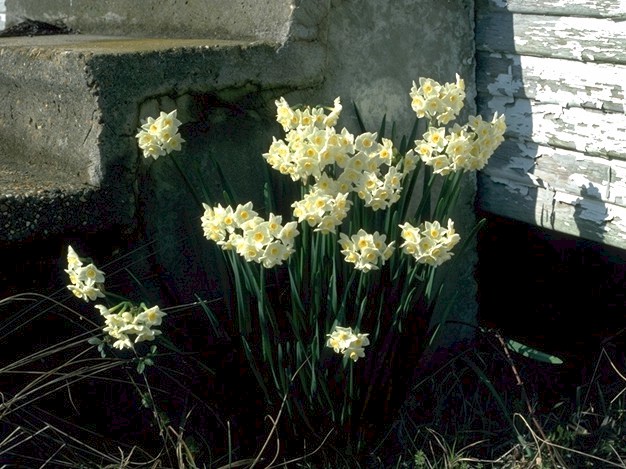Search
For The Answer
Click here to access our database of
Plant Answers
Search
For The Picture
Click here to access the Google database of plants
and insects
Information
Index
Alphabetical Listing of Topics, Recommendations
and Plants
Milberger's Nursery and Landscaping
3920 North Loop 1604 E.
San Antonio, TX 78247
210.497.3760
nursery@milbergersa.com
Open 9 to 6 Mon. through Sat.
and 10 to 5 on Sun.

Three exits east of 281, inside of 1604
Next to the Diamond Shamrock station
Please click map for more detailed map and driving directions.
Narcissus
tazetta
'Grand Primo'
(Grand Primo Narciss)
N. tazetta is considered the oldest cultivated narcissus. It was known in ancient Egypt and Greece and cultivated in Britain before 1597. In 1851">

Narcissus
tazetta
'Grand Primo'
(Grand Primo Narciss)
N. tazetta is considered the oldest cultivated narcissus.
It was known in ancient Egypt and Greece and cultivated in Britain before
1597. In 1851, Joseph Breck proclaimed them the most desirable of all
the Narcissus. Tazetta narcissus are known as polyanthus narcissus or
more often as just "narcissus" (as opposed to N. jonquilla
which are known as "jonquils" and
N. pseudonarcissus which are known as "daffodils").
The often forced paperwhite (N. tazetta papyraceous) belongs
here. Except for a few yellow types like 'Grand Soliel d'Or', tazettas
are mostly white with white, cream or yellow cups. They have clusters
of many small flowers and are intoxicatingly fragrant. Due to
their earliness of bloom, tazettas are often associated with freeze
damage. Many a bouquet has been picked the day the "northern"
blew in. As a rule, the true paperwhites are very, very, early blooming
(Christmas or New Year's even), have pure white delicate flowers, and
have a scent somewhere between cotton candy and fresh manure. Some love
it while others despise its cloyingness. True paperwhite foliage is
wide and grayish green. They are most often found naturalized along
the gulf coast where the winters are mild but are fairly abundant in
East Texas as well.
Later blooming types of tazetta narcissus are found
as you get further away from the coast where winters are more severe.
These are apparently very old hybrids between the paperwhite and the
Chinese Sacred Lily (N. tazetta orientalis) The earliest blooming
of these is the delicate but somewhat "rag-tag" N. tazetta
italicus. It has narrow, twisting petals and small, pale yellow
cups and in East Texas often blooms above stunted, freeze nipped foliage
in mid January. The most often found tazetta
narcissus in the South are several hard to distinguish variants each
of the later blooming cultivars 'Pearl' and 'Grand Primo'. The "Pearls"
seem to be whiter and earlier, while 'Grand Primo' is the latest and
initially upon opening has a citron-yellow cup. It appears that 'Grand
Primo' was sold and passed around for years under the name of 'Grand
Monarque'.
The two common forms found in East Texas are ‘Grand
Primo' with cups that fade to white and ‘Grand Primo Citronier'
with cups that stay almost yellow. They normally bloom in mid to late
February and at least in most years avoid severe freeze damage. Although
not found naturalized in East Texas, the commonly sold double flowered
form known as ‘Erlicheer' performs
very well and like other narcissus makes an excellent dried flower.
The large bulbs of tazetta narcissus are best planted
in the summer (June, July, August, or September) as they begin root
growth in October and shoot growth in the fall and early winter. However,
due to their toughness, they can realistically be transplanted at any
time of the year including full bloom. They are best planted in full
sun locations and left undisturbed,
as they should bloom and survive indefinitely. In addition to abandoned
East Texas homesites, an outstanding source for tazetta (polyanthus)
narcissus is William R. P. Welch, P.O. Box 1736, Carmel Valley, California
93924-1736. Telephone: 408-659-3830.
Revised 03/19/09




